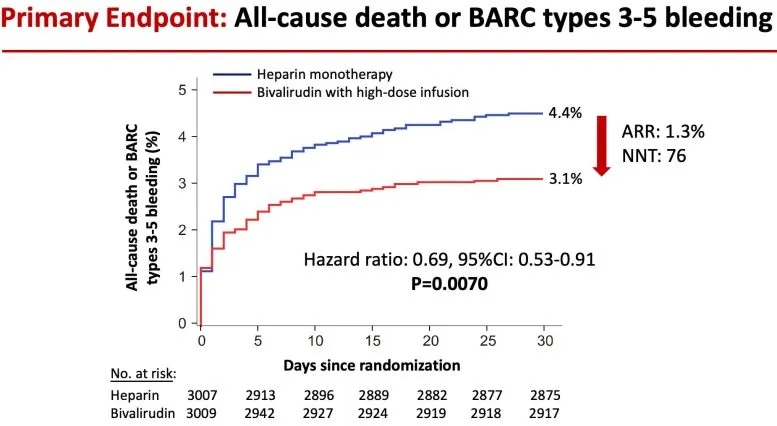博文
中美合作研究:比伐卢定可使严重心脏病死亡风险降31%
||
中美合作研究:比伐卢定可使严重心脏病死亡风险降31%
诸平


据美国纽约西奈山医院、西奈山伊坎医学院(Mount Sinai Hospital / Mount Sinai’s Icahn School of Medicine)2022年12月18日报道,中美研究人员合作,使用一种更安全、更有效的治疗最严重类型心脏病发作的药物——比伐卢定(bivalirudin),可以使死亡风险降低31%(31% Lower Risk of Death: A Safer and More Effective Drug for Treating the Most Serious Type of Heart Attacks)。
科学家们相信,改用比伐卢定每年可以挽救数十万人的生命(Fig. 1)。比伐卢定在治疗接受经皮冠状动脉介入治疗的心脏病发作患者方面比肝素(heparin)更安全、更有效。
最近的研究表明,比伐卢定是一种比肝素更安全、更有效的抗凝剂,用于治疗接受紧急经皮冠状动脉介入治疗(percutaneous coronary intervention简称PCI)的最严重心脏病发作患者,死亡率或大出血风险降低31%。
这是中国沈阳北方医院(Shenyang Northern Hospital in Shenyang, China)的韩雅玲(Yaling Han)领导的中国研究人员团队与西奈山伊坎医学院研究人员合作完成的一项新研究结果,也是首次对PCI术后最常用的两种抗凝剂(anticoagulants)进行大规模临床试验,并证实比伐卢定与肝素相比,2至4小时大剂量输注显著降低了血栓形成、大出血和死亡。
该研究结果最近在美国芝加哥举行的美国心脏协会科学会议(American Heart Association’s Scientific Sessions简称AHA 22)上的最新临床试验报告(Late Breaking Clinical Trial presentation)中公布,并于2022年11月6日已经在《柳叶刀》(The Lancet)杂志网站发表,并刊登在2022年11月26日至2022年12月2日出版的第400卷,第10366期《柳叶刀》印刷版上。详见Yi Li, Zhenyang Liang, Lei Qin, Mian Wang, Xianzhao Wang, Huanyi Zhang, Yin Liu, Yan Li, Zhisheng Jia, Limin Liu, Hongyan Zhang, Jun Luo, Songwu Dong, Jincheng Guo, Hengqing Zhu, Shengli Li, Haijun Zheng, Lijun Liu, Yanqing Wu, Yiming Zhong, Miaohan Qiu, Yaling Han, Gregg W Stone. Bivalirudin plus a high-dose infusion versus heparin monotherapy in patients with ST-segment elevation myocardial infarction undergoing primary percutaneous coronary intervention: a randomised trial. The Lancet, Volume 400, Issue 10366, 6 November 2022(Online). 26 November–2 December 2022, Pages 1847-1857. DOI: 10.1016/S0140-6736(22)01999-7. https://doi.org/10.1016/S0140-6736(22)01999-7
参与此项研究的来自美国西奈山医院和西奈山伊坎医学院的研究人员之外,主要是来自中国的研究人员,其中包括沈阳北方战区总医院( General Hospital of Northern Theater Command, Shenyang, China)、河南开封市中心医院(Kaifeng Central Hospital, Kaifeng, China)、四川大学华西医院(West China Hospital of Sichuan University, Chengdu, China)、 河南禹州市人民医院(Yuzhou City People's Hospital, Yuzhou, China)、山东泰安市中心医院(Tai'an City Central Hospital, Tai'an, China)、天津市胸科医院(Tianjin Chest Hospital, Tianjin, China)、陕西西安空军医科大学唐都医院(Tangdu Hospital of Airforce Medical University, Xi'an, China)、山东济南市第五人民医院(The Fifth People's Hospital of Jinan, Jinan, China)、辽宁沈阳医学院第二医院(The Second Hospital of Shenyang Medical College, Shenyang, China)、齐鲁医科大学附属医院,山东新泰市人民医院(Affiliated Hospital of Qilu Medical University, The People's Hospital of Xintai City, Xintai, China)、江西赣州人民医院(Ganzhou People's Hospital, Ganzhou, China)、安徽亳州人民医院(Bozhou People's Hospital, Bozhou, China)、首都医科大学附属北京潞河医院(Beijing Luhe Hospital, Capital Medical University, Beijing, China)、江西赣州市立医院(Ganzhou Municipal Hospital, Ganzhou, China)、河南商丘市第一人民医院(Shangqiu First People's Hospital, Shangqiu, China)、河南焦作市人民医院(Jiaozuo People's Hospital, Jiaozuo, China)、淮南安徽理工大学第一附属医院(The First Affiliated Hospital of Anhui University of Science and Technology, Huainan, China)、江西南昌大学第二附属医院(The Second Affiliated Hospital of Nanchang University, Nanchang, China)以及江西赣州赣南医科大学第一附属医院(The First Affiliated Hospital of Gannan Medical University, Ganzhou, China)的研究人员。
这项研究可能会产生深远的影响,它将改变全世界数十万名患有严重心脏动脉阻塞的患者的治疗方法,这种情况被称为ST段抬高型心肌梗死(ST-segment elevation myocardial infarction简称STEMI)。这是最严重的心脏病发作。STEMI患者接受肝素单药治疗(蓝色曲线)或术后输注比伐卢定(红色曲线)后直接PCI后死亡或大出血风险的降低。0.69的风险比意味着风险降低了31%。ARR(绝对风险降低率)为1.3%。NNT(为防止一例死亡或大出血而需要治疗的患者数量)为76(Fig. 2)。
此项研究的共同主要研究者、西奈山卫生系统学术事务主任(Director of Academic Affairs for the Mount Sinai Health System)、西奈山伊坎医学院(心脏病学)和人口健康科学与政策教授格、医学博士格雷格·斯通(Gregg W. Stone)说:“这项研究首次为接受支架植入术治疗STEMI心脏病发作的患者确定了最佳和最安全的治疗方案。与肝素相比,比伐卢定加短期输注显著提高了STEMI患者的存活率,并减少了两种最令人担心的并发症——大出血和支架内血栓形成。”
患有ST段抬高型心肌梗死的患者被纳入“BRIGHT-4”试验(“BRIGHT-4” trial),并接受了“初次经皮冠状动脉介入治疗”(“primary PCI”)——一种紧急支架植入术,以维持心肌功能。在这种微创手术中,患者需要抗凝治疗,以成功地打开阻塞的心脏动脉,并防止将来的血栓形成和引发另一次心脏病发作。BRIGHT-4试验是一项由研究者申办并组织的试验。该试验由中华心脏病学会基金会(Chinese Society of Cardiology Foundation: CSCF2019A01)资助,并由江苏恒瑞医药股份有限公司(Jiangsu Hengrui Pharmaceuticals Co., Ltd.)提供研究资助。
直接经皮冠状动脉介入治疗中最常用的抗凝剂是肝素。然而,它的影响在某种程度上是不可预测的,导致出血和血凝块的发生率高于预期。比伐卢定是一种新的抗凝剂,具有更可预测的“血液稀释”作用。在既往的6项针对STEMI患者的大型随机试验中,对肝素和比伐卢定进行了比较,但在这些研究中,肝素和比伐卢定的给药方案和背景疗法各不相同。这项新的研究评估了两种最广泛使用药物(肝素和比伐卢定)的治疗方案,这两种治疗方案从未在足够规模的试验中进行过直接比较。
格雷格·斯通博士和中国沈阳北方医院(Shenyang Northern Hospital in Shenyang, China)的医学博士韩雅玲(Yaling Han, MD, Ph.D)一起带领一组研究人员,于2019年2月至2022年4月期间分析了中国87个研究中心的6106名入选研究的患者。所有患者都接受了直接经皮冠状动脉介入治疗ST段抬高型心肌梗死,几乎所有患者都使用腕部的桡动脉靶向阻塞的心脏动脉。患者随机接受两种最广泛使用的肝素和比伐卢定治疗方案,之前的研究显示这两种方案是最安全和最有效的。一组仅接受肝素,通过静脉注射。另一组患者通过静脉注射比伐卢定,然后在手术后2~4小时内静脉输注高剂量比伐卢定。
研究人员在手术后对患者进行了30天的随访,在这段时间内ST段抬高型心肌梗死患者发生不良事件的风险最高。研究的主要目的是比较全因死亡率(all-cause mortality)或大出血的发生率。研究人员发现,4.4%的肝素治疗患者在30天内死亡或发生大出血,而比伐卢定治疗患者只有3.1%。总体而言,比伐卢定组与肝素组相比,死亡率或大出血率降低了31%,具有非常显著的统计学意义。
然后研究人员观察了两组患者死亡和大出血的具体发生率。他们发现,肝素治疗患者的死亡率从3.9%降至比伐卢定治疗患者的3.0%。严重出血也从肝素组的0.8%降至比伐卢定组的0.2%。这两种差异均具有统计学显著性。
他们还分析了支架内血栓形成的发生率——血管因血栓而突然闭合时发生的并发症,通常会导致第二次心脏病发作或死亡。比伐卢定组的这一比例也较低,为0.4%,而肝素组为1.1,同样具有统计学意义。
格雷格·斯通博士说:“这些结果是惊人的。与肝素相比,在心脏病发作患者的直接经皮冠状动脉介入治疗中使用比伐卢定(现在是通用药物,因此价格低廉)的简单决定每年可挽救数十万人的生命,并预防大出血和支架内血栓形成。“
上述介绍,仅供参考。欲了解更多信息,敬请注意浏览原文或者相关报道。
Background
Previous randomised trials of bivalirudin versus heparin in patients with ST-segment elevation myocardial infarction (STEMI) undergoing primary percutaneous coronary intervention (PCI) have reported conflicting results, in part because of treatment with different pharmacological regimens. We designed a large-scale trial examining bivalirudin with a post-PCI high-dose infusion compared with heparin alone, the regimens that previous studies have shown to have the best balance of safety and efficacy.
Methods
BRIGHT-4 was an investigator-initiated, open-label, randomised controlled trial conducted at 87 clinical centres in 63 cities in China. Patients with STEMI undergoing primary PCI with radial artery access within 48 h of symptom onset who had not received previous fibrinolytic therapy, anticoagulants, or glycoprotein IIb/IIIa inhibitors were randomly assigned (1:1) to receive bivalirudin with a post-PCI high-dose infusion for 2–4 h or unfractionated heparin monotherapy. There was no masking. Glycoprotein IIb/IIIa inhibitor use was reserved for procedural thrombotic complications in both groups. The primary endpoint was a composite of all-cause mortality or Bleeding Academic Research Consortium (BARC) types 3–5 bleeding at 30 days. This trial is registered with ClinicalTrials.gov (NCT03822975), and is ongoing.
Findings
Between Feb 14, 2019, and April 7, 2022, a total of 6016 patients with STEMI undergoing primary PCI were randomly assigned to receive either bivalirudin plus a high-dose infusion after PCI (n=3009) or unfractionated heparin monotherapy (n=3007). Radial artery access was used in 5593 (93.1%) of 6008 patients. Compared with heparin monotherapy, bivalirudin reduced the 30-day rate of the primary endpoint (132 events [4.39%] in the heparin group vs 92 events [3.06%] in the bivalirudin group; difference, 1.33%, 95% CI 0.38–2.29%; hazard ratio [HR] 0.69, 95% CI 0.53–0.91; p=0.0070). All-cause mortality within 30 days occurred in 118 (3.92%) heparin-assigned patients and in 89 (2.96%) bivalirudin-assigned patients (HR 0.75; 95% CI 0.57–0.99; p=0.0420), and BARC types 3–5 bleeding occurred in 24 (0.80%) heparin-assigned patients and five (0.17%) bivalirudin-assigned patients (HR 0.21; 95% CI 0.08–0.54; p=0.0014). There were no significant differences in the 30-day rates of reinfarction, stroke, or ischaemia-driven target vessel revascularisation between the groups. Within 30 days, stent thrombosis occurred in 11 (0.37%) of bivalirudin-assigned patients and 33 (1.10%) of heparin-assigned patients (p=0.0015).
Interpretation
In patients with STEMI undergoing primary PCI predominantly with radial artery access, anticoagulation with bivalirudin plus a post-PCI high-dose infusion for 2–4 h significantly reduced the 30-day composite rate of all-cause mortality or BARC types 3–5 major bleeding compared with heparin monotherapy.
https://blog.sciencenet.cn/blog-212210-1368827.html
上一篇:如何应对高危白血病
下一篇:一种用香蕉皮生产燃料的方法